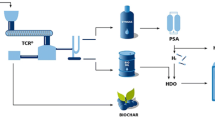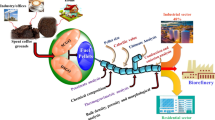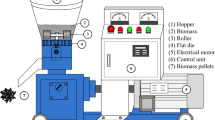Abstract
Purpose
To replace coal used in thermal power plants, this study was conducted to investigate the potential of torrefied coffee spent waste (CSW) as a fuel source.
Methods
Approximately 102 ± 2 g of CSW pellets was torrefied using electric furnaces and stainless-steel containers. The torrefaction of CSW pellets (SCG) was performed at 230 to 310 °C in 20 °C temperature increments for 1 h. To avoid oxygen reactions, a 30-min chilling period was allowed before the subsequent elemental and thermogravimetric analyses (TGA). Furthermore, decarbonization, dehydrogenation, and deoxygenation were evaluated and combustibility was observed using the combustibility index (CI) and volatile ignitability (VI).
Results
Results revealed a calorific value of 22.22–29.39 MJ/kg and mass yield rates ranging between 47.16 and 89.81%. The energy yield was 62.97–90.67%, while decarbonization, dehydrogenation, and deoxygenation were 2.99–33.85%, 12.34–74.79%, and 18.22–76.99%, respectively. No combustion issues were detected as indicated by the VI and CI values which were 19.09–26.71 MJ/kg and 30.61–82.57 MJ/kg, respectively. Compared with coal, CSW can be substitute lignite or sub-bituminous coal.
Conclusion
Torrefaction improves CSW energy properties and might be a promising alternative to wood chips as fuel. When designing a standard torrefaction boiler, temperatures of 270 ℃ or greater must be considered for optimal results.






Similar content being viewed by others
Data Availability
The datasets used or analyzed during the current study are available from the corresponding author on reasonable request.
References
Abbas, Z., & Waqas, M. (2020). Strategy on coal consumption and GHGs emission analysis based on the LEAP model: A case study. Energy Sources, Part A: Recovery, Utilization and Environmental Effects. https://doi.org/10.1080/15567036.2020.1783392
Act on the promotion of the development, use, and diffusion of new and renewable energy, pub. L. No. Presidential Decree No. 32315. Korea Legislation Research Institute. (2023).
Anshariah, Imran, A. M., Widodo, S., & Irvan, U. R. (2020). Correlation of fixed carbon content and calorific value of South Sulawesi Coal, Indonesia. IOP Conference Series: Earth and Environmental Science 473(1). https://doi.org/10.1088/1755-1315/473/1/012106
Bisset, V. (2023). The U.N. warns “an era of global boiling” has started. What does that mean? The Washington Post.
Chen, D., Cen, K., Gan, Z., Zhuang, X., & Ba, Y. (2022). Comparative study of electric-heating torrefaction and solar-driven torrefaction of biomass: Characterization of property variation and energy usage with torrefaction severity. Applications in Energy and Combustion Science 9. https://doi.org/10.1016/j.jaecs.2021.100051
Chen, Z., Li, W., Huang, S., Zhuang, P., Jia, D., Evrendilek, F., Zhong, S., Ninomiya, Y., Yang, Z., He, Y., **e, W., Liu, J., Zhuang, G., & Sun, S. (2024). Dynamic, synergistic, and optimal emissions and kinetics of volatiles during co-pyrolysis of soil remediation plants with kaolin/modified kaolin. Chemical Engineering Journal 483. https://doi.org/10.1016/j.cej.2024.149214\
Choi, S. K., Choi, Y. S., Jeong, Y. W., Han, S. Y., & Van Nguyen, Q. V. (2020). Simulation of the fast pyrolysis of coffee ground in a tilted-slide reactor. Energies, 13(24). https://doi.org/10.3390/en13246605.
Felfli, F. F., Luengo, C. A., Suárez, J. A., & Beatón, P. A. (2005). Wood briquette torrefaction. Energy for Sustainable Development, 9(3), 19–22. https://doi.org/10.1016/S0973-0826(08)60519-0
Fu, J., Lin, S., Cai, B., Liang, J., Chen, Z., Evrendilek, F., Zhong, S., Yang, Z., Yang, C., He, Y., Sun, S., & Liu, J. (2024). Catalytic co-pyrolysis of coffee grounds and polyethylene: A comparison of HZSM-5 and HY. Fuel 362. https://doi.org/10.1016/j.fuel.2023.130815
Kim, S. W. (2014). A study on the boiler efficiency influenced by coal caloric value in coal power plant. Hangyang University.
Korea Customs Service. (2023). Last year (2022), coffee (green beans + coffee beans) imports were the highest ever. Retrieved from https://www.customs.go.kr/kcs/na/ntt/selectNttInfo.do?mi=2891&bbsId=1362&nttSn=10072554.
Lee, K. T., Shih, Y. T., Rajendran, S., Park, Y. K., & Chen, W. H. (2023). Spent coffee ground torrefaction for waste remediation and valorization. Environmental Pollution, 324, 121330. https://doi.org/10.1016/j.envpol.2023.121330
Miao, Z., Pei, Z., Gao, M., Wan, K., & He, Q. (2021). Exploring a new way to generate mesopores in lignite by employing steam explosion. Energy Sources, Part a: Recovery, Utilization and Environmental Effects, 43(5), 600–610. https://doi.org/10.1080/15567036.2019.1630036
Murthy, P. S., & Madhava Naidu, M. (2012). Sustainable management of coffee industry by-products and value addition – A review. In Resources, Conservation and Recycling 66. https://doi.org/10.1016/j.resconrec.2012.06.005.
Nam, G., Kim, M., & Whan Ahn, J. (2017). Analyses for current research status for the coffee by-product and for status of coffee wastes in Seoul. Journal of Energy Engineering, 26(4), 14–22. https://doi.org/10.5855/ENERGY.2017.26.4.014
Nosek, R., Tun, M. M., & Juchelkova, D. (2020). Energy utilization of spent coffee grounds in the form of pellets. Energies 13(5). https://doi.org/10.3390/en13051235
Park, S., Kim, S. J., Oh, K. C., Cho, L., Kim, M. J., Jeong, I. S., Lee, C. G., & Kim, D. H. (2020). Investigation of agro-byproduct pellet properties and improvement in pellet quality through mixing. Energy, 190, 116380. https://doi.org/10.1016/j.energy.2019.116380
Park, S., Kim, S. J., Oh, K. C., Cho, L. H., & Kim, D. (2023a). Develo** a proximate component prediction model of biomass based on element analysis. Energies, 16(1), 509. https://doi.org/10.3390/en16010509
Park, S., Kim, S. J., Oh, K. C., Cho, L., Jeon, Y. K., & Kim, D. H. (2023b). Identification of differences and comparison of fuel characteristics of torrefied agro-byproducts under oxidative conditions. Heliyon, 9(6), e16746. https://doi.org/10.1016/j.heliyon.2023.e16746
Park, S., Jeong, H. R., Shin, Y. A., Kim, S. J., Ju, Y. M., Oh, K. C., Cho, L. H., & Kim, D. (2021). Performance optimisation of fuel pellets comprising pepper stem and coffee grounds through mixing ratios and torrefaction. Energies 14(15). https://doi.org/10.3390/en14154667.
Patel, V. R., Patel, R. N., & Rao, V. J. (2013). Kinetic parameter estimation of lignite by thermo-gravimetric analysis. Procedia Engineering, 51, 727–734. https://doi.org/10.1016/j.proeng.2013.01.104
Riaza, J., Gibbins, J., & Chalmers, H. (2017). Ignition and combustion of single particles of coal and biomass. Fuel, 202, 650–655. https://doi.org/10.1016/j.fuel.2017.04.011
Sajid, M., Khan, N., Shah, F., Kashif, M., & Khan, S. (2022). Geochemical characteristics of coal seams within the Paleocene Patala Formation, Central Salt Range coal mines (Punjab), Northern Pakistan. Journal of Sedimentary Environments, 7(2), 251–260. https://doi.org/10.1007/s43217-022-00098-3
Syivarulli, R., Pambudi, N. A., Syamsiro, M., & Saw, L. H. (2021). Upgrading the quality of solid fuel made from Nyamplung (Calophyllum inophyllum) wastes using hydrothermal carbonization treatment. Energy Engineering: Journal of the Association of Energy Engineering, 118(1), 189–197. https://doi.org/10.32604/EE.2020.010493
Tu, R., Jiang, E., Yan, S., Xu, X., & Rao, S. (2018). The pelletization and combustion properties of torrefied Camellia shell via dry and hydrothermal torrefaction: A comparative evaluation. Bioresource Technology, 264(May), 78–89. https://doi.org/10.1016/j.biortech.2018.05.009
Wu, X., Liu, J., Wei, Z., Chen, Z., Evrendilek, F., & Huang, W. (2022). Oxy-fuel co-combustion dynamics of phytoremediation biomass and textile dyeing sludge: Gas-to-ash pollution abatement. Science of the Total Environment 825. https://doi.org/10.1016/j.scitotenv.2022.153656
Yang, I., Han, G. S., & Oh, S. W. (2018). Larch pellets fabricated with coffee waste and the commercializing potential of the pellets. Journal of the Korean Wood Science and Technology, 46(1), 48–59. https://doi.org/10.5658/WOOD.2018.46.1.48
Funding
This work was supported by the Basic Science Research Program through the National Research Foundation of Korea (NRF) funded by the Ministry of Education (2021R1A6A1A0304424211). Also, this work was supported by the Korea Institute of Planning and Evaluation for Technology in Food, Agriculture and Forestry (IPET) through the Smart Farm Innovation Technology Development Program funded by Ministry of Agriculture, Food and Rural Affairs (MAFRA) (grant number 421040–04).
Author information
Authors and Affiliations
Contributions
Sunyong Park, Seok Jun Kim, and DaeHyun Kim contributed to the study conception and design. Material preparation, data collection, and analysis were performed by Sunyong Park, Seok Jun Kim, Seon Yeop Kim, Ha Eun Kim, Kwang Cheol Oh, Lahoon Cho, and Young Kwang Jeon. Supervision was conducted by DaeHyun Kim. The first draft of the manuscript was written by Sunyong Park, Seok Jun Kim, and DaeHyun Kim, and all authors commented on previous versions of the manuscript. All authors have read and approved the final manuscript.
Corresponding author
Ethics declarations
Research Involving Human Participants and/or Animals
Not applicable.
Informed Consent
Not applicable.
Competing Interests
The authors declare no competing interests.
Rights and permissions
Springer Nature or its licensor (e.g. a society or other partner) holds exclusive rights to this article under a publishing agreement with the author(s) or other rightsholder(s); author self-archiving of the accepted manuscript version of this article is solely governed by the terms of such publishing agreement and applicable law.
About this article
Cite this article
Park, S., Kim, S.J., Kim, H.E. et al. Potential of Torrefied Coffee Grounds to Be Used as Fuel in Thermal Power Plants. J. Biosyst. Eng. 49, 112–119 (2024). https://doi.org/10.1007/s42853-024-00220-5
Received:
Revised:
Accepted:
Published:
Issue Date:
DOI: https://doi.org/10.1007/s42853-024-00220-5




